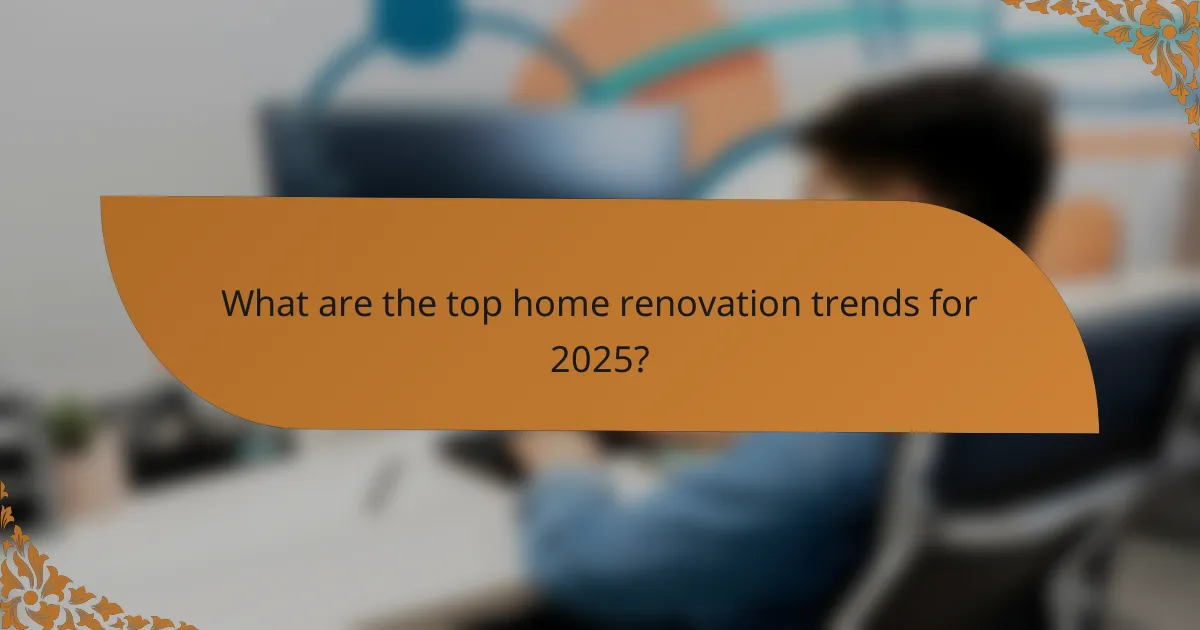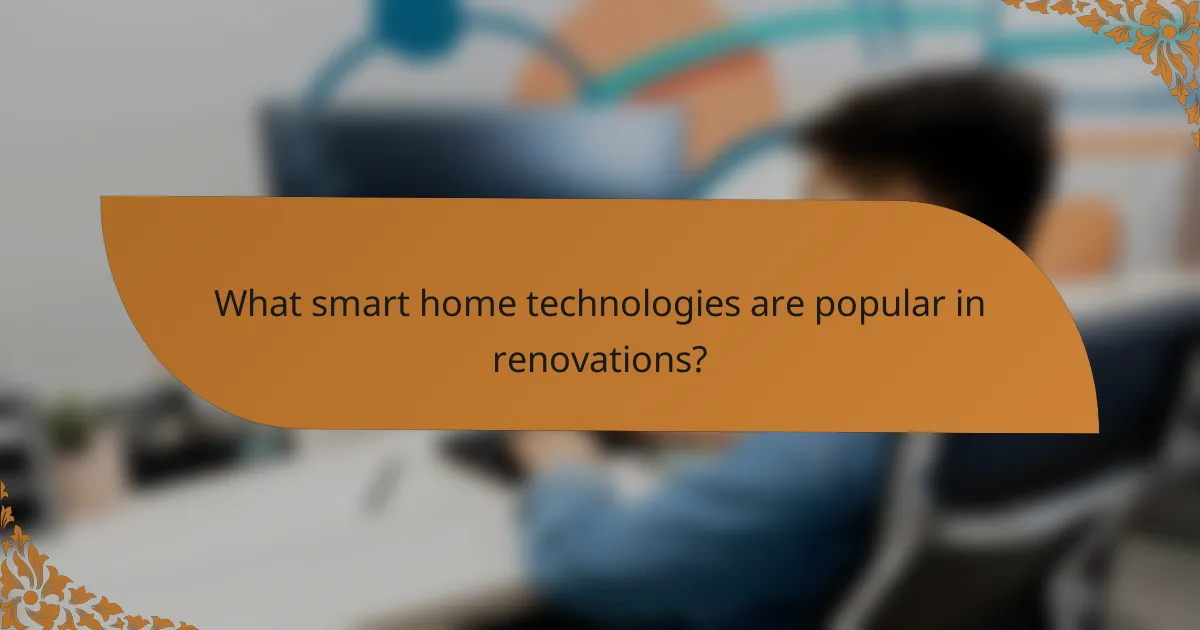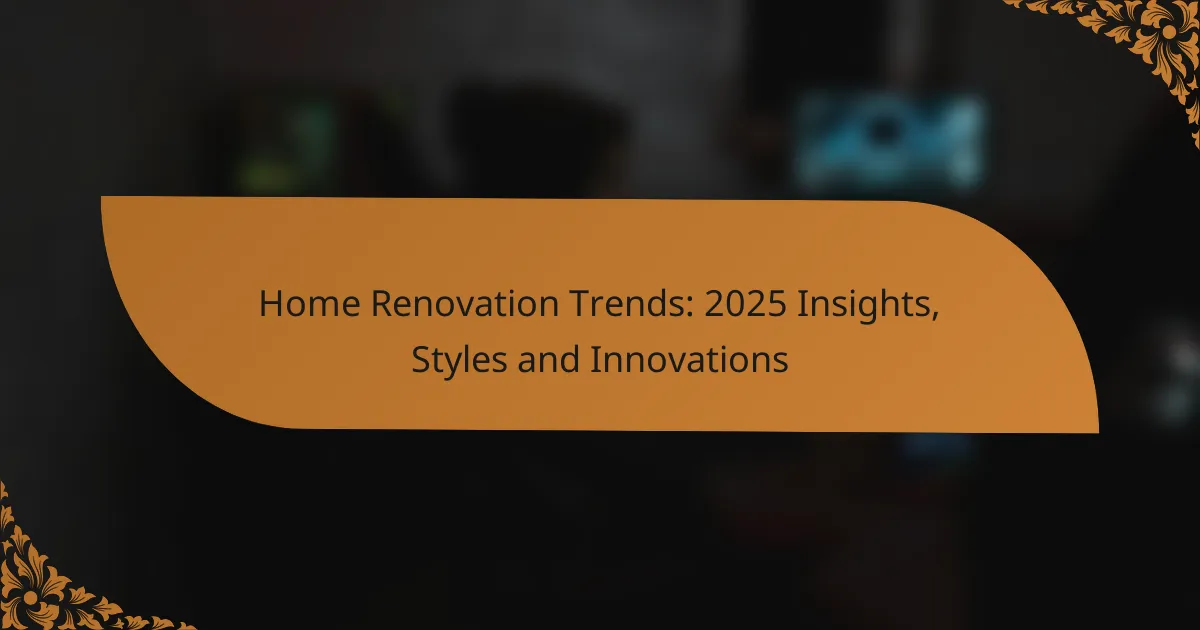As we look ahead to 2025, home renovation trends are increasingly centered around sustainability, technology, and designs that promote well-being. Homeowners are embracing eco-friendly materials and smart home innovations, creating spaces that not only enhance comfort but also minimize environmental impact. By focusing on these elements, renovations can lead to both improved quality of life and long-term cost savings.

What are the top home renovation trends for 2025?
The top home renovation trends for 2025 focus on sustainability, technology, and design that enhances well-being. Homeowners are increasingly prioritizing eco-friendly materials, smart home innovations, and layouts that foster connection and tranquility.
Sustainable materials
Sustainable materials are becoming essential in home renovations, reflecting a growing awareness of environmental impact. Options like reclaimed wood, bamboo, and recycled metal not only reduce waste but also add unique character to spaces.
When selecting sustainable materials, consider certifications such as FSC (Forest Stewardship Council) for wood products or LEED (Leadership in Energy and Environmental Design) standards for overall building practices. These choices can enhance both the aesthetic and the value of your home.
Smart home technology
Smart home technology is revolutionizing how we interact with our living spaces, offering convenience and energy efficiency. Features like smart thermostats, automated lighting, and security systems can be integrated seamlessly into renovations.
Investing in smart technology can lead to significant savings on energy bills, with some systems allowing for remote monitoring and control. Be sure to choose devices that are compatible with each other to create a cohesive smart home ecosystem.
Open-concept living spaces
Open-concept living spaces continue to dominate renovation trends, promoting a sense of flow and connectivity among different areas of the home. This layout is particularly appealing for families and those who enjoy entertaining.
When designing an open-concept space, consider the balance between functionality and aesthetics. Use furniture arrangements, area rugs, and lighting to define different zones while maintaining an overall cohesive look.
Biophilic design elements
Biophilic design elements aim to reconnect people with nature, enhancing well-being and reducing stress. Incorporating natural light, indoor plants, and water features can create a calming environment that promotes health.
To implement biophilic design, consider large windows, skylights, or green walls that bring the outdoors in. These elements not only improve air quality but also elevate the overall ambiance of your home.
Minimalist aesthetics
Minimalist aesthetics focus on simplicity and functionality, emphasizing clean lines and uncluttered spaces. This trend encourages homeowners to curate their belongings, leading to a more serene living environment.
To achieve a minimalist look, choose a neutral color palette and invest in multifunctional furniture. Avoid overcrowding spaces with decor, opting instead for a few impactful pieces that reflect your style.

How can homeowners incorporate sustainable materials?
Homeowners can incorporate sustainable materials by selecting products that minimize environmental impact, promote energy efficiency, and utilize renewable resources. This approach not only enhances the home’s ecological footprint but can also lead to long-term cost savings.
Recycled building materials
Recycled building materials, such as reclaimed wood, recycled metal, and repurposed bricks, are excellent choices for sustainable renovation. These materials reduce waste and often require less energy to produce compared to new materials. For instance, using reclaimed wood for flooring or beams can add character while being environmentally friendly.
When sourcing recycled materials, consider local suppliers to minimize transportation emissions. Check for certifications that ensure the materials meet safety and quality standards, such as the Forest Stewardship Council (FSC) for wood products.
Eco-friendly insulation options
Eco-friendly insulation options include materials like cellulose, sheep’s wool, and spray foam made from natural substances. These alternatives not only provide effective thermal resistance but also have lower environmental impacts compared to traditional fiberglass insulation. For example, cellulose insulation, made from recycled paper, can significantly reduce energy costs over time.
When choosing insulation, consider the R-value, which measures thermal resistance. Aim for insulation that meets or exceeds local building codes for energy efficiency. Additionally, verify that the materials are free from harmful chemicals to ensure a healthier indoor environment.
Low-VOC paints
Low-VOC (volatile organic compounds) paints are designed to minimize harmful emissions during application and drying. These paints contribute to better indoor air quality and are available in a wide range of colors and finishes. Homeowners should look for paints labeled as low-VOC or zero-VOC to ensure they are making a healthier choice.
When selecting low-VOC paints, consider the durability and washability of the product, especially for high-traffic areas. Brands often provide information on the VOC levels, so choose those with the lowest levels for the best environmental impact. Additionally, ensure proper ventilation during application to further reduce indoor air pollutants.

What smart home technologies are popular in renovations?
Smart home technologies are increasingly integrated into renovations, enhancing convenience, efficiency, and security. Popular options include smart thermostats, automated lighting systems, and home security integrations, each offering unique benefits for modern living.
Smart thermostats
Smart thermostats allow homeowners to control their heating and cooling systems remotely, optimizing energy usage and comfort. These devices can learn your schedule and preferences, adjusting temperatures automatically to save on energy bills, often reducing costs by around 10-15%.
When selecting a smart thermostat, consider compatibility with your existing HVAC system and features like geofencing, which adjusts settings based on your location. Popular brands include Nest and Ecobee, known for their user-friendly interfaces and energy-saving capabilities.
Automated lighting systems
Automated lighting systems enhance both convenience and energy efficiency by allowing users to control lights through smartphones or voice commands. These systems can be programmed to turn on or off at specific times or in response to motion, providing added security and reducing energy waste.
When implementing automated lighting, consider options like smart bulbs or integrated systems that work with existing fixtures. Brands such as Philips Hue and Lutron offer a variety of choices, from simple bulb replacements to comprehensive home lighting solutions.
Home security integrations
Home security integrations include smart cameras, doorbell cameras, and alarm systems that can be monitored remotely. These technologies enhance safety by providing real-time alerts and video feeds, allowing homeowners to respond quickly to potential threats.
When choosing security systems, look for features like two-way audio, night vision, and integration with other smart devices. Popular options include Ring and Arlo, which offer comprehensive packages that can be tailored to fit various budgets and security needs.

What are the benefits of open-concept living spaces?
Open-concept living spaces offer numerous advantages, including improved flow and versatility in home design. These layouts eliminate walls between key areas, creating a more spacious and inviting environment.
Enhanced natural light
One of the primary benefits of open-concept living is the increased natural light that floods the space. With fewer walls obstructing windows, sunlight can penetrate deeper into the home, reducing the need for artificial lighting during the day.
To maximize this benefit, consider using large windows or glass doors that connect indoor and outdoor areas. Skylights can also be an effective way to bring in additional light, especially in areas that may otherwise feel dark.
Improved social interaction
Open-concept designs foster better social interaction among family members and guests. By removing barriers, such as walls, individuals can engage in conversations and activities without feeling isolated from one another.
This layout is particularly beneficial during gatherings, as it encourages a more communal atmosphere. For instance, while cooking in the kitchen, you can easily converse with guests in the living area, enhancing the overall experience.
Increased property value
Homes with open-concept layouts often see a boost in property value due to their modern appeal and functionality. Many buyers today prefer these designs, viewing them as more desirable and contemporary.
When considering renovations, keep in mind that open spaces can attract a broader range of potential buyers. However, ensure that the design remains practical and does not compromise essential areas, such as storage or privacy, which could detract from overall value.

What are the key factors in choosing a renovation contractor?
Choosing a renovation contractor involves evaluating their qualifications, experience, and reliability. Key factors include their portfolio, references, and understanding of your project needs.
Experience and portfolio
When assessing a contractor’s experience, consider how long they have been in the renovation business and the types of projects they have completed. A seasoned contractor typically has a diverse portfolio showcasing various styles and complexities, which can indicate their versatility and expertise.
Reviewing a contractor’s portfolio allows you to gauge their workmanship and design sensibility. Look for projects similar to yours in scale and style, as this can help ensure they are capable of meeting your specific requirements.
Additionally, ask for references from past clients to gain insight into their reliability and professionalism. A contractor with a strong track record of satisfied customers is more likely to deliver quality results on your renovation project.
